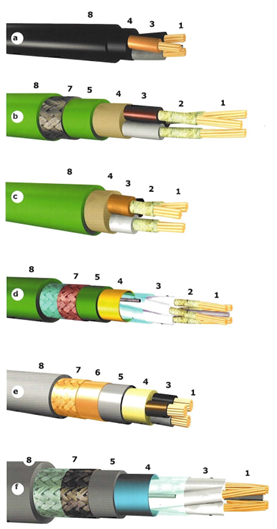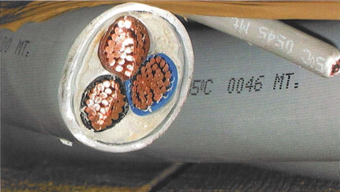Electric Cables
Electric Cables
- low smoke
- fire resistant.
Application of such more sophisticated cables like for instance the fire resistant variety will reduce the consequences and damage of a fire contrary to the commercially attractive PVC-insulated types. These pvc cables generate toxic and corrosive gases during a fire, resulting in a lot more damage to the installation than the parts which are directly damaged by the fire.
A disadvantage, however, of the low smoke types of cables is that their mechanical properties, as strength against mechanical stress while being pulled, is considerably less with the possibility of damage with installation.
Cables

a. Normal three-core power cable
b. Fire resistant screened power cable
c. Fire resistant power cable
d. Fire resistant control cable
e. Double screened (EMC) power cable
f. Overall screened signal cable.
Cables for ship's installations differ from those for on-shore installation by the way the conductor is built up. Instead of a solid conductor as in most on-shore or industrial cables, a marine cable consists of a stranded conductor consisting of 7 or more wires to cope with the vibrating environment.
This does not mean that a MARINE cable is flexible enough for a nonfixed or a moving installation. A further difference with on-shore installations is that cables in a marine environment must be fixed to the cable supports.
Flexible cables for moving installations such as cranes or telescopic supported wheelhouses are fixed to movable cable trays.
1.Core of twisted copper conductors
2. Mica wrap
3. Core insulation
4. Filler
5. Inner sheath
6. Copper wrap
7. Braiding copper or galvanized steel
8. Outer sheath
Cables with solid conductors up to 2.5 mm2 can be used in ship's accommodations. See for details of shipboard cables the relevant IEC standards.
Screened power cable consisting of, in addition to the above cable, 4 copper sheath, 5 and 6 galvanised steel wire braiding. Screened single core AC power cables shall have a non-magnetic screen, because a steel braiding will heat up by the magnetic field resulting from the current in the cable.
The same is applicable when single core AC power cables pass through a steel bulkhead penetration. The sum of the currents through such a penetration shall be zero. Also gland plates for single core cables shall be of non-magnetic materials.
Screened multicore control cable consisting of laid up twisted pairs.
Fire resistant cable
Cables which should remain functioning under fire conditions have a similar construction as other cables, but are provided with an additional layer of mineral insulation around the conductors, in this case mica tape. It is amazing to see how this simple measure makes the cable fire resistant, not only in straight lengths but also in bent parts of the cable run.
Tests have been performed at several cable manufacturers' works where straight and bent pieces of cables have been subjected to a standard fire test up to 1000 °C for a period of one hour. These cables remain in service, with acceptable megger readings between the conductors and between conductors and earth.
The cores are found still capable to transport electrical power, which means that no wire is interrupted. When fire resistant cables are used all other parts of the system like junction boxes involved, should also be fire resistant.
Application fire resistant cables
Fire resistant cables are applied when the circuits have to remain in operation under fire conditions. This is mainly limited to safety and fire fighting circuits such as emergency lighting, fire detection, alarming circuits, communication circuits and fire safety shutdown circuits. Fire resistant cables shall be used to ensure continuity of service in spaces adjacent to the space which could be damaged by fire. For example emergency lighting circuits routed through an engine room supplying a steering-gear room. The same is applicable to a public address circuit running through a fire zone servicing loudspeakers in a next fire zone.
Another example is a fire door, which requires electric power to close, has to get its supply by a fire resistant cable from a safe area. If the door would close by itself when the power supply is interrupted, a normal cable would be acceptable.
The same is applicable to any sort of safety equipment or essential propulsion equipment. Duplicated essential propulsion equipment shall not be powered from the same source or be powered by cables routed along a common cable run other than protected individually against mechanical and fire damage.
Cable selection tables
The table on the next page shows the cable ratings for various types of cables for an ambient temperature of 45° C. When cables are installed in an area with a different ambient temperature, the correction factors as per table on the top of the page should be applied.
Example:
A cross linked PE cable of 3 x 4 has a current rating of 27A. When this cable is installed in an area with an ambient temperature of 60° C a correction factor of 0.79 must be applied. The current rating then will be 0.79 x 27 = 21.33A
Note: correction factors for bunching of cables may also be applied and class rules must be consulted for the corresponding values

To indicate the quality of the cable, codes are printed on the outside, according to the production standard
Correction factors for cables


In order to determine the necessity for fire resistant cables and the cable routing, the approved Safety Plan showing the watertight bulkheads, fire resistant bulkheads and decks, the A-60 insulation and the fire zones, is required.
Larger cross-sections are considered unsuitable for installation on ships because of their size and associated bending radius.
Parallel cables have to be routed in such a way that sufficient air can circulate for cooling. If this is not the case, de-rating factors must be applied.
AWG in the above table refers to American Wire Gauge which is the cross section as per American standards.
When a cable is damaged due to a too high ambient temperature, and has to be replaced, the proper quality cable has to be chosen. Refitting using the same quality cable will result in the same damage, or the allowed current has to be reduced as per table above.
 +7 (812) 4-673-673
+7 (812) 4-673-673